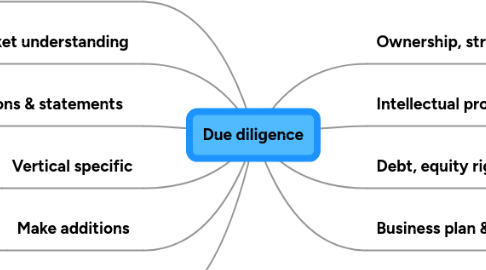
1. Management qualifications and agreements
1.1. Resume and CV
1.2. Outside activities
1.3. Governance
1.3.1. Advisors
1.3.2. Board
1.4. startup track record
1.4.1. References
1.4.2. SOS entities and standing
1.4.3. fundraising expertise
1.4.4. Environment
1.5. Investment in venture
1.6. Reasonable startup salaries
1.7. Responsiveness
1.8. Accuracy
2. Market understanding
2.1. Customer ecosystem
2.1.1. primary research results
2.1.2. product specification desires
2.1.3. Who buys
2.1.4. Who decides
2.1.5. Who pays
2.1.6. Current users or buyers
2.2. Competition analysis
2.3. Market size references
2.4. related portfolio companies
2.5. Customer Segments
2.5.1. Value Propositions
2.5.2. Segment sizes
2.5.3. Customer relationships and channels
2.5.4. Customer Archetypes
3. Financial projections & statements
3.1. Financials
3.1.1. Audited financials
3.1.2. Historical financial statements
3.1.3. financing history
3.1.3.1. Source of capital
3.1.3.2. Terms
3.1.4. Burn rate
3.1.5. Cash on hand
3.1.6. Schedules
3.1.6.1. Accrued expenses
3.1.6.2. liabilities
3.1.6.3. related-party transactions
3.1.7. Matches capitalization and securities
3.1.8. Securerd leans clear
3.2. Projections
3.2.1. Total capital needs
3.2.2. Breakeven point
3.2.3. Funding sources
3.2.4. Capital Costs
3.2.5. Use of funds
3.2.6. Valuation
3.2.7. Staffing
3.2.8. Sales initiation
3.2.9. Life time value
3.2.10. Customer Acquisition Costs
3.2.11. Gross margin
3.2.12. Net contribution margin
4. Vertical specific
4.1. Technology general
4.1.1. stage of development (TRL)
4.1.2. Platform technology
4.1.3. Independent review and validation
4.1.4. protected and defensible
4.1.5. disruptive
4.2. Franshise
4.2.1. The offering (Franchise disclosure document)
4.2.2. Royalty
4.2.3. Initial payment
4.2.4. Level of control
4.2.5. Level of support
4.2.6. Marketing support and responsibility
4.2.6.1. Materials
4.2.6.2. Advertising ownership
4.2.6.3. Websites
4.2.7. National accounts
4.2.8. Additional requirements
4.2.8.1. Annual meetings
4.2.8.2. Training requirements
4.2.8.3. Management reports or meetings
4.2.8.4. Minimum purchases
4.2.8.5. Performance requirements
4.2.8.6. Termination/Separation
4.2.9. Founder background
4.2.10. Legal
4.2.10.1. Lawsuits
4.2.10.2. Contracts
4.2.10.3. Other
4.3. Wind Farm Diligence
4.4. Digital Health
4.4.1. Understanding of Ecosystem
4.4.2. Clear path to get paid
4.4.2.1. Reimbursement plan
4.4.2.2. Consumer value chain
4.4.3. Understanding of health IT budgets and sources
4.4.4. Transition plan for early adopters
4.4.5. Consumer experience
4.4.6. KOL list
4.4.7. Clinical validation and endorsements
4.4.8. Unique data streams
4.4.9. CAC/LTV
4.4.10. Regulatory plan
4.5. Biologics
4.5.1. Therapeutic focus
4.5.2. Clinical data
4.5.3. CMC issues
4.5.4. Competitive landscape
4.5.5. Regulatory plan and correspondence
4.5.6. Asset protection regarding samples and banks
5. Make additions
5.1. Tweet to Make additions
6. Tips to prepare
6.1. Understand M&M principle
6.2. Terry's simple things list
6.3. How to develop an FAQ document
6.4. Seven Habits of Highly Effective Data Rooms
7. Ownership, structure & capitalization
7.1. Paid in capital
7.2. Total common shares
7.3. Options and warrants
7.4. Issued shares documentation
7.4.1. Certificates
7.4.1.1. Legends
7.4.1.2. Copies
7.4.2. Board votes
7.4.3. Stockholder approvals
7.5. Model capitalization to exit
7.6. Capitalization legal opinion
7.7. Use Equity Management Software
7.7.1. Carta | Equity Management
7.8. Voting rights model
8. Intellectual property & licenses
8.1. Freedom to operate
8.1.1. patent searches
8.1.2. license agreements
8.1.3. infringement letters
8.2. Barrier to entry
8.2.1. filing dates
8.2.2. Other
8.2.3. switching costs
8.2.4. regulatory advantages
8.3. Intellectual property portfolio
8.3.1. Patents
8.3.1.1. Status
8.3.1.1.1. filing dates
8.3.1.1.2. geography
8.3.1.1.3. prosecution history
8.3.1.2. Ownership
8.3.1.2.1. assignments
8.3.1.2.2. licenses
8.3.1.2.3. Chain of custody
8.3.2. License agreements
8.3.2.1. Royalty
8.3.2.2. patent costs
8.3.2.3. fixed fees
8.3.2.4. termination clauses
8.3.2.5. Good Standing
8.3.3. Trademarks, copyrights, trade secrets
8.3.4. IP growth plan
8.3.5. Policies and procedures
8.3.6. Employment agreements
8.3.7. Legal representation
9. Debt, equity rights & deal terms
9.1. Corporate form
9.1.1. Bylaws
9.1.2. C-corp
9.1.3. Charter and amendments
9.2. Previous series and terms
9.2.1. Preferences
9.2.2. Anti-dilution
9.2.3. Investor credibility
9.2.4. Valuation
9.2.5. Paid in capital
9.3. Other sources of capital
9.4. List of all contracts
10. Business plan & pitch
10.1. Demonstrated traction in fundraising
10.2. Professional pitch and plan
10.2.1. Team
10.2.2. Value proposition
10.2.3. Competitive advantage
10.2.4. Market
10.2.5. Intellectual Property
10.2.6. Marketing plan
10.2.7. Operational plan
10.2.8. Regulatory plan
10.2.9. Government regulations
10.2.10. Financial projections
10.2.11. Exit strategy
